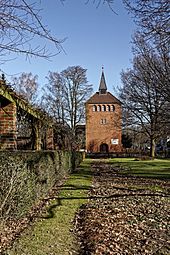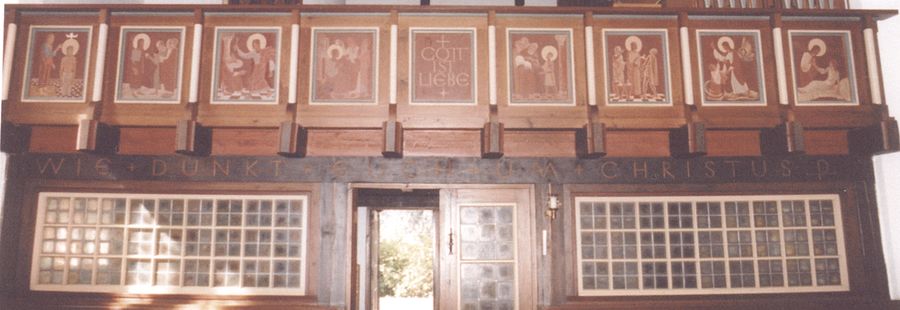Maria Magdalenen Church (Klein Borstel)
The Evangelical Lutheran Maria Magdalenen Church is located on Stübeheide street on the edge of Frank's settlement in the Hamburg district of Klein Borstel . It was named after Maria Magdalena , the companion of Jesus and witness of his resurrection.
History and church building
The church was planned as part of the local amenities that were necessary for the new Frank'sche settlement. The foundation stone, which shows the year of construction in 1938, is on the back wall of the chancel in the pastor's garden. From the laying of the foundation stone on February 6, 1938 to the inauguration on the 3rd Advent, December 11, 1938, both the raw brick building and most of the interior fittings were completed. The architects Bernhard Hopp and Rudolf Jäger included in their planning the desire for community rooms in the tower, so that it was given a massive shape that offers two more tower rooms above the organ gallery. The actual church space can be expanded through the vestibule, as the small glass window panes with their frames can be sunk into the partition wall to the nave. In total, the nave can accommodate over 400 visitors. The total outside length of the church is about 31.5 m and the width about 18 m.
The inscription on the beam above the partition reads: "Be still and know that I am God" ( Ps 46:11 EU ). In 1965, the font planned by architect Hopp in 1938 was realized by Fritz Fleer .
Interior
Sanctuary
The wall paintings in the chancel were designed by Bernhard Hopp and H. Junker. On the central wall of the chancel there is a large picture of the scene of the cross. Above the cross stands the Bible verse: "I give you a new commandment that you love one another, just as I loved you" ( Jn 13:34 EU ).
The scene of the cross depicts the situation that is also described in the Gospel of John: “But at the cross of Jesus stood his mother and his mother's sister, Mary, Cleopha's wife, and Mary Magdalene. When Jesus saw his mother and the disciple whom he loved standing by, he said to his mother, "Woman, behold, this is your son!" Then he said to the disciple: Behold, this is your mother! ”( Jn 19 : 25-27 EU ). This is about the namesake of the church. The posture of Jesus' head indicates the conversation situation - and thus also helps to decipher who of the six people (in the following numbered from left to right) is Mary Magdalene:
Person 1 (from left) is u. A. indicated by a beard as an older man in a slightly turned away position. From person 6 only the back of the head and parts of the hairstyle can be seen. Three of the people (2, 3 and 4) are clearly recognizable as women. The speaking of Jesus, indicated by the posture of his head and mouth, is directed at person 5, who in turn looks at person 2, so that the passage with the words addressed to the favorite disciple John would be most likely to be thought of: “See, your mother! ". For person 2, this would assume that the mother of Jesus is to be represented here, which was possibly expressed with the gray-white hair color of an older woman. So only person 3 and 4 remain as candidates for identification as Maria Magdalena. These two differ in that person 3 grasps with their hand around person 2, which would express the closer personal relationship graphically, and would be traced back to the designation “his mother's sister” in John 19.25 EU . So only person 4, who has a hint of a headscarf over her hair, remains as Mary Magdalene. She is a witness to the crucifixion on Good Friday.
On Easter morning, too, it is she who comes to the grave early in Joh 20 EU and finds the stone rolled away. Afterwards she sees the Lord and proclaims the risen One. The basalt plate with the cross above the empty grave, which was placed on the altar in 1946, contains this central text of the Easter message: "He is risen".
pulpit
The pulpit was designed by Bernhard Hopp. The event on the cross in the center of the sanctuary is surrounded on the front, left gallery parapet of five images that represent the prehistory of Holy Week: the entry into Jerusalem ( Mk 11 EU ), the prayer in Gethsemane ( Mk 14.32 EU ), the Jesus captured ( Mk 14.43 EU ), before Pilate ( Mk 15 EU ), on the Way of the Cross - Simon of Cyrene ( Mk 15.21 EU ).
To the right of the pulpit, the history of the post-Easter congregation is presented chronologically in a frieze of pictures and text:
Gallery parapet
As on the pulpit, the picture frieze on the gallery balustrade on the central panel is marked by a text that takes up the Bible word above the cross: "God is love". This includes the reference to the Spirit of God formulated in the foundation stone document.
Eight surrounding panels illustrate the way of Jesus:
| The baptism of Jesus by John the Baptist | "Give the emperor what is the emperor's" | The temple cleansing | The anointing of Jesus | GOD IS LOVE |
The 12 year old Jesus in the temple | The wedding at Cana | Peter's petty belief | "Girl, get up" |
| Mk 1,9f EU | Mt 22.15ff EU | Mk 11.15ff EU | Mk 14.3 EU | 1 Jn 4,16 EU | Lk 2.41 EU | Joh 2 EU | Mt 14.30f EU | Mk 5.37 EU |
Below the parapet in the church room on the two beams that support the gallery is the biblical phrase "How do you feel about Christ [?]" Mt 22.42 EU During the time the church was built in 1938, this question was a deliberate reference to a dialogue between Jesus to see with his Jewish interlocutors. Their answer, which traces the sonship of Christ back to David, emphasizes a counter-position to a “de-Judetian” Christianity, which was desired in some circles during the Nazi era. A similar confession is also the last bar inscription in the anteroom above the exit: "He is our peace" Eph 2,14 EU , which refers to the announcement of the Hebrew Bible in Mi 5,4 EU .
Plaque
This design of the construction period was worked out together with the architects, the mother parish of St. Lukas and with the first pastor, Rudolf Timm, who was introduced into his office at the same time as the inauguration of the church on December 11, 1938. For Timm (NSDAP and SA member, also describing his theological position as that of the Confessing Church), who died in the war in 1942, a memorial plaque was set into the north wall in the anteroom.
organ
The first organ was built in 1949 by Emanuel Kemper & Sohn (Lübeck). In 1964 a new gaming table was installed . Today's instrument comes from the Rudolf von Beckerath company in 1980. It has 17 registers , which are divided between two manuals and a pedal . The game actions are mechanical, the stop action electric. The disposition is:
|
|
|
|||||||||||||||||||||||||||||||||||||||||||||
- Coupling : II / I, I / P, II / P
- Playing aids : 4-fold setting system
Pastors
The following pastors were active in the Maria Magdalenen Church:
- Eckardt Günther, 1935–1936
- Otto Bahnsen, 1936–1937
- Rudolf Timm, 1938–1939
- Short-term representation during the war:
- Muus, 1939
- Uhlmann, 1939-1940
- Sword, 1940
- Jungheinrich, 1941
- Degen, 1941-1945
- Dwenger, 1945
- Carl Malsch , 1945–1954
- Walter Kersten, 1954–1970
- Christoph Kretschmar, 1970–1977
- Adolf Kayser, 1977–1988
- Harald Wienicke, 1988–1991
- Jürgen Bobrowski, 1991-2004
- Elisabeth Fischer-Waubke, 2004–2015
- Detlef Melsbach, since 2015
literature
- Uwe Gleßmer and Emmerich Jäger: On the history of the origins of the Klein Borstel community and the Maria Magdalenen church . Books on Demand , Norderstedt 2016, ISBN 978-3-7392-4416-7 , pp. 148 .
- Friedhelm Grundmann , Thomas Helms: When stones preach . Medien Verlag Schubert, Hamburg 1993, ISBN 3-929229-14-5 , p. 126 .
- Christiane von Knorre: A church without iron and steel - on the building situation in 1938 (= in: Kirchengemeinde Maria-Magdalenen (Hrsg.): 75th Kirchweihfest. Ev.-Luth. Parish Maria-Magdalenen in Hamburg Klein-Borstel 1938-2013 ). Self-published, Hamburg 2013, p. 18-21 .
Individual evidence
- ^ Ralf Lange: Architecture in Hamburg . Junius Verlag , Hamburg 2008, ISBN 978-3-88506-586-9 , p. 238 .
- ^ Dirk Schubert: Hamburg residential quarters . Dietrich Reimer Verlag, Berlin 2005, ISBN 3-496-01317-6 , p. 190 .
- ↑ Bracker, D .: How do we testify to the sonship of Jesus after the Synoptics? in: Das Evangelische Hamburg (from March 1937 'Das Niederdeutsche Luthertum') 1937 pp. 250–252 (continued with further articles pp. 282–284, 299–300, 328–332). Online here
- ↑ Günter Seggermann, Alexander Steinhilber, Hans-Jürgen Wulf: The organs in Hamburg . Ludwig, Kiel 2019, ISBN 978-3-86935-366-1 , pp. 129 .
- ↑ organindex.de: Organ Mary Magdalene Church , accessed on 1 February 2017th
- ↑ Festschrift der Gemeinde from 1998, p. 27 (deviating from Bahnson Gleßmer / Jäger (2016) p. 27f) and Herwarth von Schade : Hamburg pastors since the Reformation. Ed. Temmen, Bremen 2009.
- ↑ A new pastor for the Vier- und Marschlande. Dreieinigkeitskirche Allermöhe-Reitbrook website, February 16, 2015, accessed on February 3, 2017.
Web links
Coordinates: 53 ° 38 ′ 1.4 ″ N , 10 ° 3 ′ 21.1 ″ E





